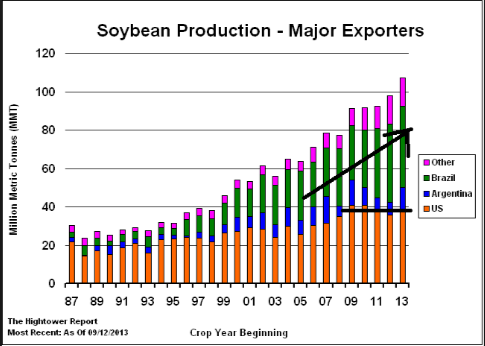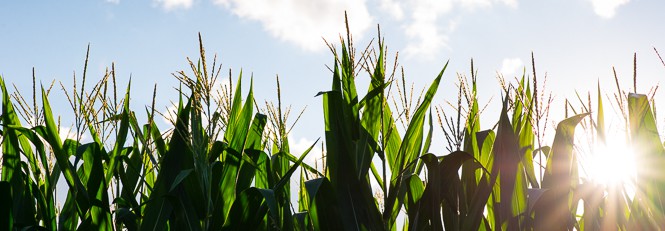Brazil- Up and Coming Producer
South America, and more specifically Brazil, has become a major producer and key player in world soybean production. So much so that the level of production that is taking place in South America has come up to par with the level of soybean production that we have here in the United States. Now, if you were to ask your neighbor 10 years ago if he or she thought that agriculture in Brazil would progress to the level of production that it is at today, the answer would have been “no way is that possible.”
The fact of the matter is that Brazil has come a very long way in a very short time in terms of increasing tillable acres, and increasing their total crop production. If you look at the graph below you will notice that since about 2000, Brazil’s soybean production has been rising at a faster rate than the US soybean production. On the other hand, it appears that US soybean production has not been rising as quickly as Brazil. The USDA has the Brazil soybean production for 2016 forecast at 102.0 million metric tonnes. As for the US, the USDA has soybean production forecast at 128.7 million metric tonnes.

(Photo Cred: The Hightower Report)
Why the rise in production?
Over the past two decades, massive deforestation has taken place in Brazil in order to bring more land into production agriculture. Thousands of acres have been cleared to increase soybean production in Brazil and also for cattle to graze. The rise in Brazil’s
soybean production can mostly be attributed to the expansion of available crop land- not so much to their increase in yields. The ground that is being transitioned from rain forest into production crop land has very low fertility.
(Photo cred: thetruthisdirty.com)
Growing Pains
Although Brazil’s agriculture sector is thriving as far as production is concerned, the major issue that farmers are faced with is the severe lack of infrastructure. Brazil has made substantial progress towards being one of the largest soybean producers in the world, but the lack of infrastructure to support the rise in commodities moving out of the country poses a severe problem. Paved roads a re nearly non-existent in rural Brazil, where crops need to be transported hundreds of miles to port to be exported. The lack of usable roads increases transportation costs for producers; costing as much as three times what it costs to send crops to down the Mississippi River here at home.
re nearly non-existent in rural Brazil, where crops need to be transported hundreds of miles to port to be exported. The lack of usable roads increases transportation costs for producers; costing as much as three times what it costs to send crops to down the Mississippi River here at home.
(Photo cred: farmersjournal.ie)
As a result, the high
transportation costs decrease the profitability of the farms. Grain storage is another problem in Brazil. There is very little on-farm storage and even fewer grain elevators. Many farms resort to bagging soybeans in the field- risking theft and possible exposure to the elements if tampered with. Construction had been started on a cross-country highway in Brazil to aid in transporting commodities to port, however with the recent political problems, construction ceased to continue.
Overview
Brazil has certainly come a long way in terms of agriculture production, with remaining room for improvement. There is the potential that Brazil could be the top producer of soybeans in the world. In order for this to be sustainable though, there are many factors that need to improve. The first being infrastructure improvements. If Brazil were to build paved roads in rural areas, they would be able to transport their commodities much faster and at a much lower cost than the current situation. Lastly, with political unrest in Brazil, there are many uncertainties. Progress is hard to achieve with the current political situation in Brazil. If conditions were to improve as far as infrastructure and government, there would be little holding Brazil back from excelling in the global market. I think we can all agree that we should feel lucky to live in the United States and have a decent political system and infrastructure that is better than most.
—–
Hello, I am Garrett Sprenger. I am Senior at WIU majoring in Agriculture Business and will graduate in December 2016. I am from west central Illinois where I farm with my dad and raise commercial beef cattle. After graduation I will most likely return to the farm and continue driving truck for DOT Foods.
.



Just wondering really, do you think its a good thing that they are clearing out the rain forest in Brazil for more crops? I personally don’t see a big deal just because they probably do need more food. Just wanted your opinion on the matter.
LikeLike
Hire, I don’t believe that it is a good thing that they are clearing the rain forests for crop production. For one, the fertility of the soil is very poor for crop production and, forests don’t just grow back overnight. They need to preserve their forests as much as possible in my opinion.
LikeLike
Another reason they are growing so much is because they are able to sell their crop in American dollars instead of their own currency. Which makes them more money.
LikeLike